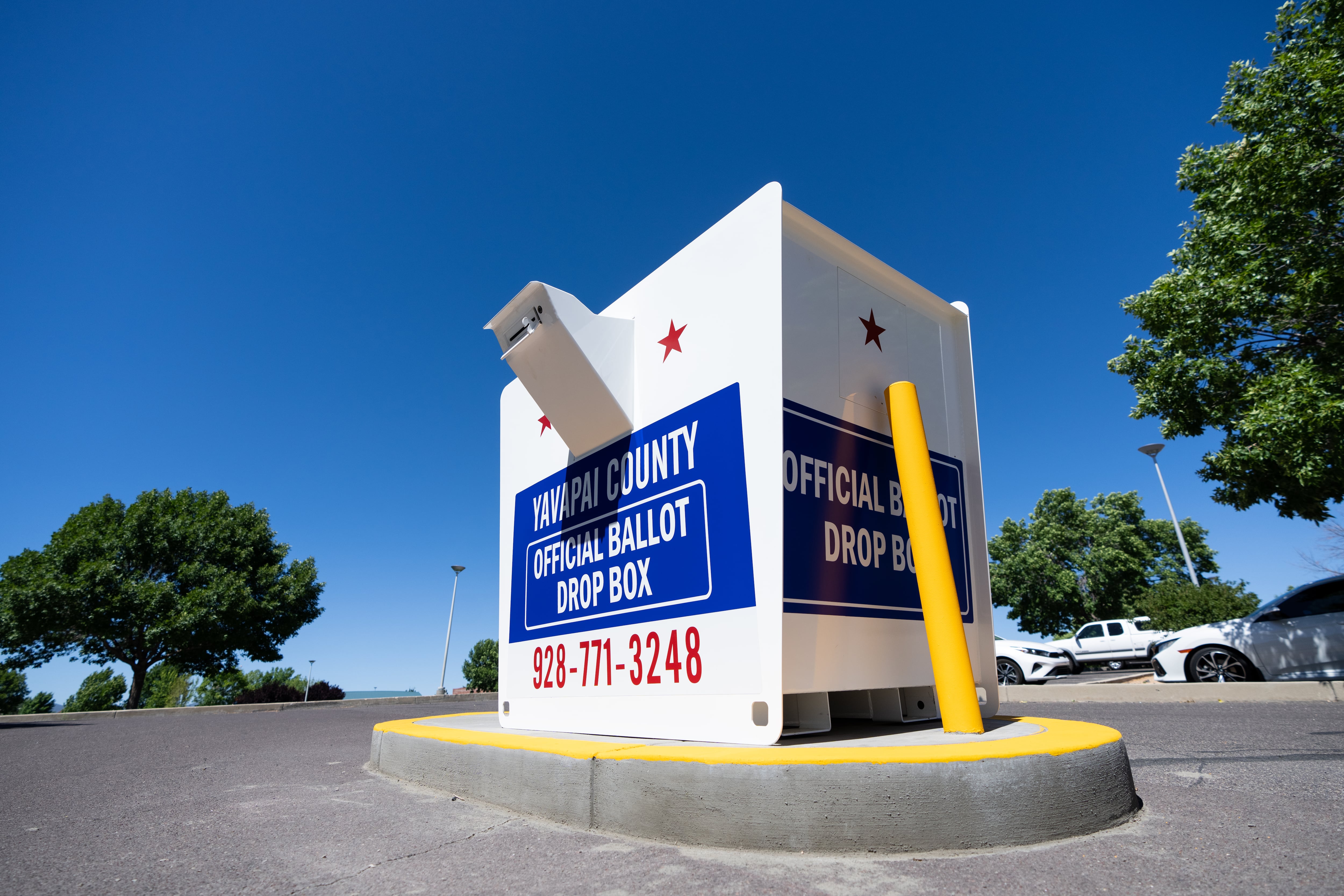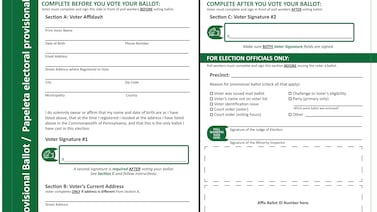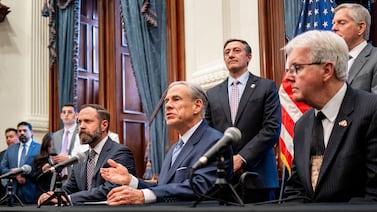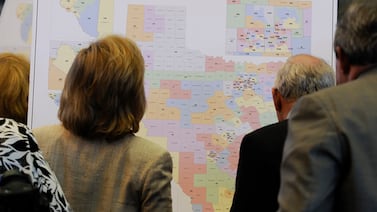In the weeks leading up to August’s primary election, ballot drop boxes were getting a bad rap on the right. The documentary “2000 Mules,” which has been widely discredited, nonetheless supercharged claims that drop boxes enabled fraud. The now-nominee for Republican governor in Arizona told her followers not to use drop boxes. The Republican nominee for secretary of state, in the lead-up to his primary win, told his followers to monitor drop boxes and attacked the ones that weren’t guarded by live cameras.
So it’s not surprising that Democrats were more likely than Republicans to use a mail ballot in the 2022 state primary. But despite all the rhetoric, plenty of Republicans across the state still used both mail ballots and drop boxes. A Votebeat analysis of data provided by multiple counties shows ballot drop boxes remain a popular voting option for all Arizonans, including in Republican-dominated areas.
In several of the counties Votebeat analyzed, drop box use increased in this year’s primary compared with past primaries.
Take Republican-heavy Yavapai County, where claims about 2020 election fraud are common. About 50% of voters used a ballot drop box to vote in this year’s primary, up from 33% in the 2020 primary. In Yuma County, more than 20% of voters who cast a primary ballot did so at a drop box, and most of them were returning Republican ballots. In the 2020 primary, that number was just under 16%.
Most counties didn’t provide a partisan breakdown of the ballots received via drop boxes in this primary, and only three provided data going back farther than 2020. The limited data makes it difficult to see clear trends in most counties. In addition, the COVID-19 pandemic prompted more people to vote by mail and use drop boxes in 2020 rather than in person, and experts warn against assuming that will continue.
Votebeat requested drop box usage data from every Arizona county. Ten of the 15 counties responded by publication time with at least some data — or, in the cases of Pima, Mohave, and La Paz counties, to say they do not use drop boxes.
Cochise, Graham, Navajo, Yavapai, and Yuma counties were the only counties that provided historical data over multiple comparable elections. (Maricopa County’s only available historical data was from the November 2020 election, a skewed comparison point given the high turnout in presidential general elections.) Votebeat calculated the percentage of each county’s voters who used drop boxes by dividing the number of ballots received in drop boxes by the number of total ballots cast, according to each county’s canvassed election results.
When it comes to returning the early ballots many voters receive in the mail, Arizonans have options. They can send it back through the U.S. Postal Service to their local elections offices. They can return it to a polling place during the four weeks of early in-person voting or on Election Day, handing it to an election worker or dropping it at a box within that polling site that’s monitored and available only while the polling place is open. Or they can use a drive-up or walk-up drop box, typically a large metal box similar to a mail collection box, known as a drop box.
In rural areas, especially, drop boxes provide a convenience and reduce ballot travel time. Returning a ballot through the mail sometimes sends it on a circuitous journey out of the county to a major mail-processing center before it loops back to the county’s election office just miles away from the sender.
“Voters like convenience at the end of the day, and if you know that you can walk to a drop box or that there’s one conveniently located on your route to work or to the store, that convenience may outweigh some of the rhetoric that’s out there,” said Benjamin Gonzalez O’Brien, a political science professor at San Diego State University who has studied drop boxes.
“But I just think that that rhetoric does undermine trust and faith in our system of elections, and I think it’s incredibly dangerous, even if we don’t know if it has a direct effect on the likelihood of someone using drop boxes. But that’s also very hard to measure empirically.”
What Arizona county drop box data shows
Debunked claims of “mules” stuffing ballot drop boxes haven’t seemed to slow the use of drop boxes in largely rural Yavapai County, a heavily Republican area north of Phoenix. The boxes have long been extraordinarily popular with voters there. And the county has been responsive to some voters’ interest in increased security of the boxes themselves.
“We definitely still see all parties use it,” said Michelle Burchill, the newly appointed recorder in Yavapai County. “So far, we have not seen a huge drop off by one party compared to another as far as usage is concerned.”
Nearly 26% of Yavapai’s voters used a drop box to return a ballot in the 2018 primary. In the 2022 primary, it went up to nearly 51%. The county had the state’s highest turnout during this year’s primary, too, the state’s canvass shows.
Based on concerns Yavapai officials heard from voters, the county affixed cameras to its 19 drop boxes for the 2022 primary, Burchill said. Bipartisan teams of vetted and background-checked county employees pick up the ballots regularly. Each time they do, they bring the footage back from the cameras, too.
“We’ve gotten a lot of really great feedback from our voters, who say that it gives them an extra feeling of security knowing that there’s some sort of footage in case there’s some funny business happening,” Burchill said.
To date, there have been no reports of any such funny business in connection with the primary, she said.
Graham County, a rural county southeast of Phoenix, added more drop boxes in the 2020 general election, increasing from one to five, three of which are available for drop-offs 24/7. The county kept all five boxes for the 2022 primary — and usage of these drop boxes increased accordingly, data from county recorder Wendy John shows.
In the 2018 primary, 416 voters used the single drop box. In this year’s primary, 1,002 people dropped ballots off across the five boxes. Of those, 741 were Republican ballots, John said. Republicans make up the largest proportion of registered voters in the county by far.
And in Yuma County, where two women were recently charged with ballot collection related to a local election in August 2020, drop box usage hasn’t slowed. After “2000 Mules,” the film’s creators erroneously claimed the county investigated ballot collection problems spurred by the movie.
Local officials have repeatedly noted that the local cases — the first charges since a 2016 law banned the practice of collecting and submitting someone else’s ballot, with some exceptions, in Arizona — did not stem from or relate to the documentary. And the Republican attorney general’s office has provided records that show True the Vote, the group behind the movie, hasn’t turned over evidence to support its claims, despite repeated requests over an extended time period.
In the 2020 presidential primary, drop boxes were used by nearly 16% of voters who cast a ballot in Yuma County. This year, during the primary, just over 20% of voters who voted used a drop box. (The county didn’t have data from 2018’s midterm elections.)
And of those who dropped their ballot at a Yuma drop box this primary election, nearly 61% returned Republican ballots, the county’s election director, Tiffany Anderson, told Votebeat.
“I think the use of secure ballot drop boxes continues to be popular, even in heavily Republican areas, due to the convenience,” Anderson said via email. “There is also some lingering concern over the postal service, especially since all Yuma’s mail goes to Phoenix for sorting and then back to Yuma for distribution. The drop boxes provide a much more direct path for the ballot to be received by the County Recorder’s Office.”
This year, Anderson said the county moved five of its drop boxes inside the libraries where they had previously been located outside, because of concerns over voter intimidation and voter and election worker safety. The sixth drop box, located outside the county’s elections office, was still available 24/7 and under video surveillance. There were no reports of voter intimidation in Yuma’s August primary, so two additional drop boxes will be placed outside libraries in two high-traffic areas, she said.
In Navajo County, the number of drop boxes expanded from six in the 2018 primary to 17 in this year’s primary, data from the county shows. Nearly 22% of voters used a drop box in the 2022 primary, compared with about 14% in the 2018 primary.
The six drop boxes in 2018 were in the county’s larger communities, while the 11 additional drop boxes were put in more rural areas to give “all residents equal opportunity to use a drop box if they choose,” Navajo County Recorder Michael Sample said via email.
Cochise County, in southern Arizona, did show a decrease in drop box usage from the 2020 primary to the 2022 primary, the only two years for which the county provided data. In the 2020 primary, about 16% of voters used a drop box. This primary, it was about 10%, a change partly explained by different voting patterns in presidential election years and especially during the height of the pandemic.
Why are they popular?
Drop boxes appeared in many new places during the 2020 election, spurred by the COVID-19 pandemic and voters’ wariness of voting in person. But Arizona, where no-excuse mail voting has been in place for three decades, has long used them.
Voters use drop boxes for convenience — driving up and dropping in a ballot is typically quick and easy, especially if they’re placed in highly trafficked areas. The drop boxes take a ballot directly from a voter to a county employee, making them reliable and secure. And, for voters who may forget to mail back their ballot in time for it to arrive by Election Day, they provide a direct way to make sure the vote is counted. For voters who work non-standard hours, 24-hour drop boxes can help. In more rural areas, the drop box may be closer than other voting options.
Voters have told Yavapai’s Burchill that they trust the county employees and appreciate the direct route to them.
“That’s my personal preference, if I’m voting — I would rather trust and know that it’s going directly into the hands of somebody within the elections department,” Burchill said.
The Bipartisan Policy Center, a nonpartisan think tank, recommends that drop boxes be placed near public transportation routes and near places like community centers and public libraries, said Rachel Orey, the associate director for the center’s Elections and Congress Projects. If the drop box isn’t inside a staffed elections office, the BPC recommends that the box be securely attached to the ground, be locked at all times with tamper-evident seals and be under 24-hour video surveillance. Ballots should be picked up regularly by bipartisan teams, Orey said.
Studies have shown that drop boxes can increase voter participation and turnout. Any additional steps between a voter and casting a ballot can reduce the likelihood that they’ll vote, Gonzalez O’Brien said.
“We don’t have spectacularly high voter turnout, especially in midterm elections, off-year elections. And so anything that increases turnout even a little is incredibly beneficial for our system of democracy,” Gonzalez O’Brien said.
Political attacks on drop boxes
Since the 2020 election, and the various election fraud claims that never seem to die down, drop boxes have been under increased scrutiny by lawmakers in several states.
In Georgia, which first used outdoor 24/7 drop boxes in the 2020 election, the Republican-controlled Legislature restricted drop boxes, saying they needed to be inside polling locations with set hours. That move meant longer travel times for some voters and led to “restricting access to drop boxes in counties that used them the most, which also have the highest number of voters of color and Democrats,” an analysis by NPR, WABE and Georgia Public Broadcasting found.
In Wisconsin, the state Supreme Court recently ruled that drop boxes were not allowed for absentee ballots in the state because state law allows ballots to be returned via mail, but “ballot drop boxes, however, are not mailboxes.”
The Arizona Legislature tried, but failed, to get rid of unmanned ballot drop boxes, with some lawmakers wanting to ban drop boxes entirely. Here, the boxes aren’t specifically part of state law. Instead, the state’s election procedures manual permits the use of drop boxes, which must be approved by local county supervisors. It also lists a set of requirements if drop boxes are used, like locations, security measures, and pick-up procedures.
One legislative measure related to drop boxes did pass: a pilot program to create “smart” drop boxes in some counties. Those boxes would have cameras attached, issue a receipt for each ballot, and only accept one ballot at a time. Ballots would be rejected if the camera wasn’t working.
These smart boxes, which had never been manufactured at the time the program was approved with the state budget, won’t be ready in time for the November election.
A pilot program in Orange County, California, Orey pointed out, included some drop boxes that had a scanner attached to give voters the option to scan a QR code before depositing their ballot, as a way to track their ballot.
Even proponents of drop boxes say the idea of adding a camera and receipt system isn’t a bad idea.
“If that helps to lessen some fears that voters have about using those drop boxes and feel more confident in the security of the election, then that’s a step we should take,” Gonzalez O’Brien said.
Rachel Leingang is a freelancer for Votebeat and co-founder of the Arizona Agenda. Contact Rachel at rleingang@votebeat.org.







